
The raspberry is the edible fruit of several plant species in the genus Rubus of the rose family, most of which are in the subgenus Idaeobatus. The name also applies to these plants themselves. Raspberries are perennial with woody stems.

Mangosteen, also known as the purple mangosteen, is a tropical evergreen tree with edible fruit native to Island Southeast Asia, from the Malay Peninsula to Borneo. It has been cultivated extensively in tropical Asia since ancient times. It is grown mainly in Southeast Asia, southwest India and other tropical areas such as Colombia, Puerto Rico and Florida, where the tree has been introduced. The tree grows from 6 to 25 m tall.
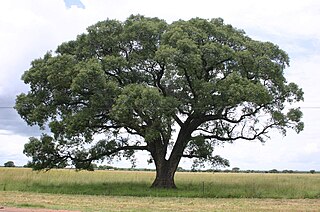
Sclerocarya birrea, commonly known as the marula, is a medium-sized deciduous fruit-bearing tree, indigenous to the miombo woodlands of Southern Africa, the Sudano-Sahelian range of West Africa, the savanna woodlands of East Africa and Madagascar.
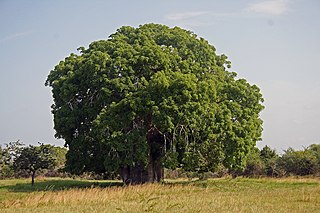
Adansonia is a genus made up of eight species of medium-to-large deciduous trees known as baobabs or adansonias. They are placed in the family Malvaceae, subfamily Bombacoideae. They are native to Madagascar, mainland Africa, and Australia. The trees have also been introduced to other regions such as Asia. A genomic and ecological analysis has suggested that the genus is Madagascan in origin.

Harpagophytum, also called grapple plant, wood spider, and most commonly devil's claw, is a genus of plants in the sesame family, native to southern Africa. Plants of the genus owe their common name "devil's claw" to the peculiar appearance of their hooked fruit. Several species of North American plants in the genus Proboscidea and certain species of Pisonia, however, are also known by this name. Devil's claw's tuberous roots are used in folk medicine to reduce pain.
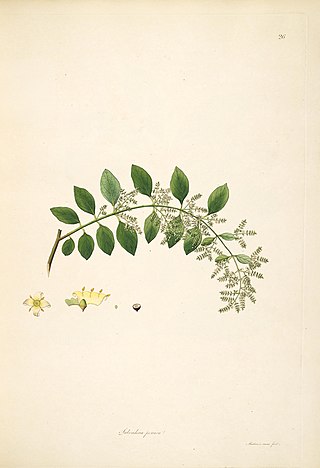
Salvadora persica or the toothbrush tree is a small evergreen tree native to the Middle East, Africa and India. Its sticks are traditionally used as a natural toothbrush called miswak and are mentioned by the World Health Organization for oral hygiene use.

Nyctaginaceae, the four o'clock family, is a family of around 33 genera and 290 species of flowering plants, widely distributed in tropical and subtropical regions, with a few representatives in temperate regions. The family has a distinctive fruit type called an accessory fruit or anthocarp, and many genera have extremely large pollen grains.

Opuntia ficus-indica, the Indian fig opuntia, fig opuntia, or prickly pear, is a species of cactus that has long been a domesticated crop plant grown in agricultural economies throughout arid and semiarid parts of the world. O. ficus-indica is the most widespread and most commercially important cactus. It is grown primarily as a fruit crop, and also for the vegetable nopales and other uses. Cacti are good crops for dry areas because they efficiently convert water into biomass. O. ficus-indica, as the most widespread of the long-domesticated cactuses, is as economically important as maize and blue agave in Mexico. Opuntia species hybridize easily, but the wild origin of O. ficus-indica is likely to have been in central Mexico, where its closest genetic relatives are found.

Malus sieversii is a wild apple. According to DNA analysis conducted in 2010, it is the primary ancestor of the domesticated apple, M. domestica.

Sideroxylon spinosum, known as argan, synonym Argania spinosa, is a species of flowering plant. It is a tree endemic to the calcareous semi-desert Sous valley of southwestern Morocco and to the region of Tindouf in southwestern Algeria. Argan trees grow to 8–10 m (26–33 ft) high and live up to approximately 200 years. They are thorny, with gnarled trunks and wide spreading crown. The crown has a circumference of up to 70 m (230 ft) and the branches may lean towards the ground.

Adansonia digitata, the African baobab, is the most widespread tree species of the genus Adansonia, the baobabs, and is native to the African continent and the southern Arabian Peninsula. These are long-lived pachycauls; radiocarbon dating has shown some individuals to be over 2,000 years old. They are typically found in dry, hot savannas of sub-Saharan Africa, where they dominate the landscape and reveal the presence of a watercourse from afar. They have traditionally been valued as sources of food, water, health remedies or places of shelter and are a key food source for many animals. They are steeped in legend and superstition. In recent years, many of the largest, oldest trees have died, for unknown reasons. Common names for the baobab include monkey-bread tree, upside-down tree, and cream of tartar tree.

The long-snouted bat is a species of bat in the family Phyllostomidae. It is the only species within the genus Platalina. It is endemic to northern Peru and northern Chile. It feeds almost exclusively on the nectar and fruit of the columnar cactus. The species is rare, but has a wide distribution with at least 25 populations, and is listed as near-threatened due to habitat loss causing the removal of their primary food source.

Juncus articulatus is a flowering plant species in the rush family Juncaceae. It is known by the common name jointleaf rush or jointed rush, which can also refer to J. kraussii from Australia. It is native to Eurasia, Canada, Greenland and much of the United States. It grows in moist areas, such as wet sand, and thrives in calcareous soils. J. articulatus was found to be more sensitive to drought and salt stress than its congeners J. acutus and J. maritimus. It is a perennial herb producing mainly erect stems from a short rhizome. The stem may root at nodes, and it generally has one or more flattened hollow cylindrical leaves up to 10 centimeters long. Transverse internal partitions or joints may be seen or felt in the leaf of the plant.
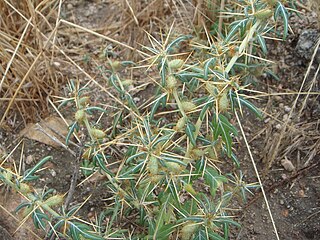
Xanthium spinosum is a species of flowering plant in the aster family known by many common names, including spiny cocklebur, prickly burweed and Bathurst burr. This species is part of the genus Xanthium that encompasses 25 different species of flowering plants of the daisy family, Asteraceae, and sunflower tribe.
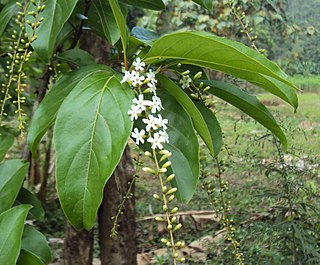
Citharexylum spinosum is a species of flowering plant in the family Verbenaceae that is native to southern Florida in the United States, the Caribbean, Guyana, Suriname, and Venezuela. Common names include Florida fiddlewood and spiny fiddlewood.

Schleichera is a monotypic genus of plants in the soapberry family, Sapindaceae. There is only one species, Schleichera oleosa, a tree that occurs in the Indian Subcontinent and Southeast Asia.

Catophractes alexandri, the only species in the genus Catophractes, is a spiny shrub or small tree up to 3m tall, belonging to the family Bignoniaceae and occurring in the hot, low-rainfall regions of Namibia, the Northern Cape, Kalahari Desert, Botswana, western Zimbabwe and Limpopo. Preferring calcrete, limestone outcrops and soils, the species often forms pure communities, or grows in association with Colophospermum mopane, Rhigozum virgatum, Phaeoptilum spinosum and Acacia nebrownii. It is parasitised by several Tapinanthus spp.

Didelta spinosa, belonging to the family of Asteraceae, is a Southern African woody shrub or small tree endemic to the West Coast and found from Saldanha Bay in the south across the Gariep into the south-west corner of Namibia. Growing 2–3 m tall and drought-resistant, its preferred habitat is on dry, rocky slopes. This species was introduced to Europe by Thunberg and Masson.

Commicarpus is a genus of flowering plants belonging to the family Nyctaginaceae. The genus contain some 30 to 35 species which are native to the tropics and subtropics. Most are found in Africa and western Asia, and eight species are native to southern Africa.
The 2018–2021 Southern Africa drought was a period of drought that took place in Southern Africa. The drought began in late October 2018, and negatively affected food security in the region. In mid-August 2019, the drought was classified as a level 2 Red-Class event by the Global Disaster Alert and Coordination System. The alert level was reduced to the Orange-1.7 by 12 December 2019, as the new wet season had started. In September 2020, the drought was classified as a level 2 Red-Class event. The drought continued into early 2021. Beginning in October 2021, South Africa experienced above average rainfall and reservoirs refilled by early 2022.
























